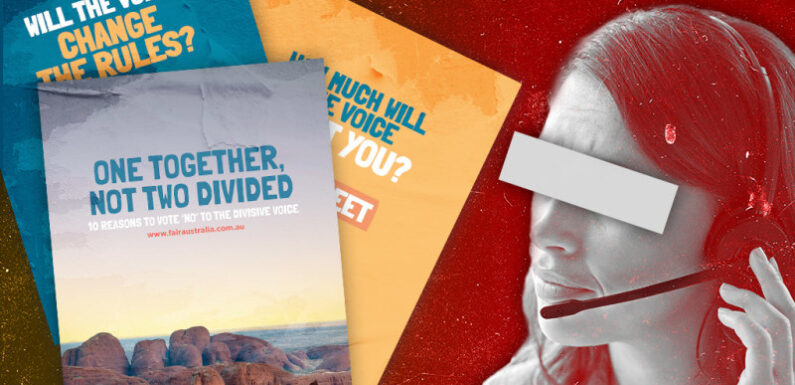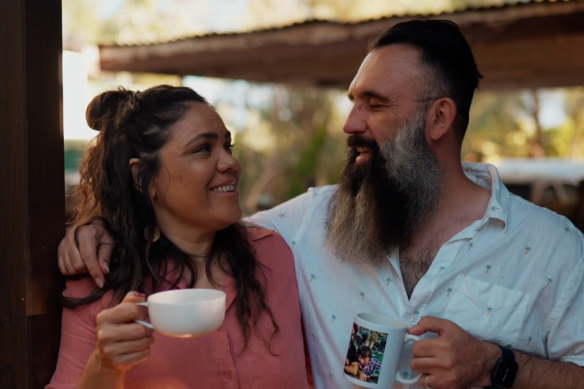
Save articles for later
Add articles to your saved list and come back to them any time.
The campaign to sink the Voice has instructed volunteers to use fear and doubt rather than facts to trump arguments used by the Yes camp.
In an online training session, the national campaigning chief for leading No activist group Advance, Chris Inglis, detailed the anti-Voice movement’s core strategy of playing on voters’ emotions.
Volunteers are told not to introduce themselves as working with the No campaign. Credit: Robert Rough
Inglis instructed volunteers not to identify themselves upfront as No campaigners as they make hundreds of thousands of calls to persuadable voters, but instead to raise reports of financial compensation to Indigenous Australians if the Voice referendum were to succeed.
“When reason and emotion collide, emotion always wins. Always wins,” he said as he displayed the same quote from US psychology professor Drew Westen, author of The Political Brain.
The No case is now leading in several national polls ahead of the October 14 referendum. The latest RPM poll published on Monday shows support for the Indigenous Voice slumping to 43 per cent, with voter sentiment swinging against the constitutional amendment in every state except Tasmania.
Inglis explained at the meeting on Monday, August 28, that the No camp’s job is to make people suspicious of the Voice and its backers, while the Yes campaign continued to cite academic arguments and documents such as the Uluru Statement.
“This is the difference between facts and figures or the ‘divisive Voice’,” the long-time Liberal Party staffer said. “That feeling of uncertainty, of fear or doubt, that stays. That lasts for a very, very long time.
“I’m going to hammer in a lot of this emotive language.
“If you took everything that I had just said and turned it into one little thing, this is what you should write down and remember forever so you can tell your kids, tell your grandkids, tell your nephews and nieces: that people vote based on how they feel.”
Advance runs the leading No campaign Fair Australia, which is aligned with the Coalition’s Indigenous Australians spokeswoman, Senator Jacinta Nampijinpa Price.
Advance was started in 2018 as a conservative counterweight to GetUp and counts former prime minister Tony Abbott on its advisory board. It claims it has a 250,000-strong supporter base fighting “woke politicians and elitist activist groups … taking Aussies for a ride with their radical agenda”.
Jacinta Price and husband Colin Lillie feature in a Fair Australia ad campaign.Credit:
It is not suggested that either Price or Abbott endorses the coaching methods outlined in the training session run by Inglis.
Scripts used by Advance’s 10,000-strong network of phone campaigners show how they are taught not to introduce themselves as calling from “the No campaign”.
Instead, they are asked to sound as if they were concerned citizens associated with Fair Australia who “heard” the Voice will push for financial compensation for Aboriginal people.
“It’s been designed purely for soft voters. If we had put [No] in the opening line … that in itself will scare people, right?” Inglis told volunteers.
“It’s not from the ‘No campaign’ … Fair Australia’s soft, it’s calming.”
The script states: “I’ve also heard that some of the people who helped design the Voice proposal are campaigning to abolish Australia Day and want to use the Voice to push for compensation and reparations through a treaty. All of these things raised a few questions in my mind and made me wonder if there was more to it all than meets the eye”.
Inglis told supporters that phone canvassing – using a tool called CallHub employed by successful campaigns in Europe and the United States – was integral to Advance’s efforts.
If 250 people attend a phone calling session, Inglis said, they could reach 15,000 so-called “soft” voters yet to make a firm decision.
Inglis, a former ACT Liberal staffer, said in the briefing that he had worked on state and federal election campaigns for about 12 years.
His briefing outlined Advance’s “three-wave plan” through Fair Australia to defeat the Voice.
The strategy was first deployed in autumn, when No campaigners started raising awareness of the Voice as an issue of concern.
In winter, the conservative activists began talking about the “Voice of division”.
As referendum day nears, the Fair Australia campaign has begun discussing the consequences of voting Yes and asking Australians to act by rejecting the proposal.
A Fair Australia spokesman said the volunteer briefing was standard practice across all sides of politics and the campaign’s messaging reflected the actual concerns of voters.
“We make no apologies for our volunteers being as persuasive as they possibly can be,” he said.
“Every single volunteer is asked to identify themselves as calling from Fair Australia, and any suggestion to the contrary is a flat-out lie.
“Yes campaign supporters have nothing better to do but deceptively infiltrate our campaign and provide potentially illegal recordings to left-leaning news outlets. We will be referring the matter to the federal police and taking further advice.”
Price’s office was contacted to comment on Advance’s strategies.
Opposition Leader Peter Dutton’s office declined to comment.
This masthead previously reported that senior members of the Liberal Party are wary of Advance’s ability to radicalise the party’s membership base. The Liberals have made sure the party’s databases and resources are not shared with Advance during the Voice campaign.
Last month, The Australian detailed a cheat sheet for Yes volunteers seeking to shift sentiment through phone calls, instructing them to “name the villain, or unfair barrier, including who or what is harming us and why – pick a villain that most people dislike or distrust”.
Indigenous Australians Minister Linda Burney said in June that she feared the No campaign had imported “American-style Trump politics to Australia”.
Cut through the noise of federal politics with news, views and expert analysis. Subscribers can sign up to our weekly Inside Politics newsletter here.
Most Viewed in Politics
From our partners
Source: Read Full Article

